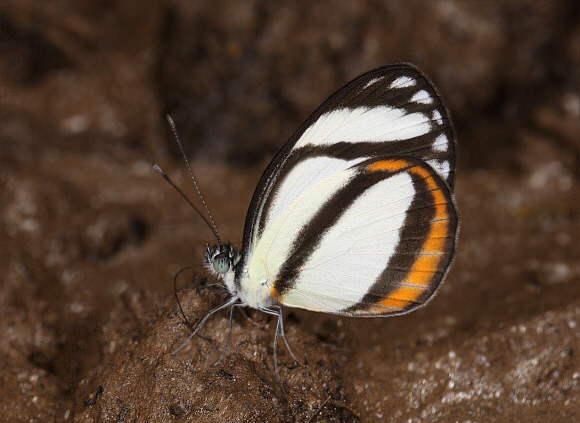 Itaballia pandosia pisonis Ecuador – Tony Hoare
Itaballia pandosia pisonis Ecuador – Tony Hoare
Introduction
This little butterfly belongs to a genus containing only 3 species – pandosia, marana and demophile, all confined to the neotropical region.Itaballia pandosia is the smallest member of the genus, with a wingspan of about 50mm, and can be confused with the Dismorphiine Moschoneura pinthous, which flies in similar habitats and has a similar flight pattern. The latter species however is slightly smaller at 45mm, and has a series of white submarginal spots on the underside hindwings.
The insect illustrated is the subspecies pisonis, which occurs throughout the Amazonian regions of Brazil, Ecuador and Peru. Other subspecies occur in Costa Rica, Colombia and Venezuela.
Habitats
The butterfly is found in wet primary rainforest habitats at elevations between about 200-800m.
Lifecycle
The following applies in general to Itaballia, although I have no data specific to pandosia :The eggs are yellow, and laid singly under the leaves of Capparis ( Capparidaceae ). The larvae are typically green with yellow and blue tubercles. The chrysalis is whitish and adorned with black spikes on the back. It is formed on a mat of silk spun on the upper surface of Capparis leaves.
Adult behaviour
Males appear to be territorial, as they are usually seen singly, although other males are invariably present in the vicinity, dotted along the length of a forest trail at intervals of about 50 metres. They tend to spend several minutes at a time perched on low foliage growing along narrow but fairly well lit trails, typically within a few metres of riverbanks. They generally prefer the shade of the forest understorey but occasionally visit sunlit river beaches to imbibe mineralised moisture.
The butterflies are nervous, and if disturbed they fly quickly to resettle on another nearby leaf, usually higher up, but always within 3 metres of ground level. Continued disturbance simply causes them to repeat the process endlessly, and often results in them eventually returning to their original perching place. This habit is very reminiscent of the behaviour of certain Ithomiines.
